This antenna design came about following discussions about what antennas to use for the RSGB 21/28MHz contest. Eventually it was decided to go for a loop on each band. This article describes the construction of the 10m version, although the 15m version is similar.
I had had some success previously with a loop cut for 17m (slightly long) on 20, 17, 15 and 10m with regular contacts in South America and the USA and I know other members have similar experience of both Delta and Quad loops.
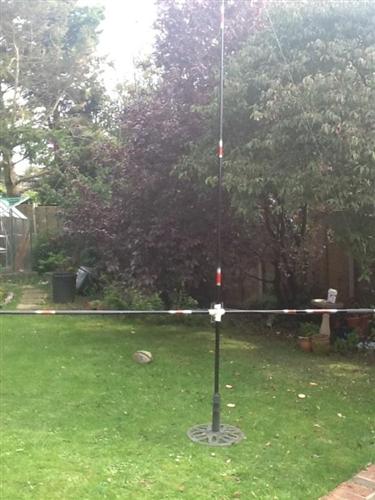
Making a wire loop for 10m is quite simple and doesn’t require any special skills with most materials being available from DIY stores and the junk box. The idea was to make something that was reasonably rigid and could be supported on the top of a 12m Racal mast and could be turned to face E-W or N-S and all points in between. That gave some challenges as it needed to conform to the following specification:
-
Single band with flat SWR across 28.000 to 29.000 MHz
-
Lightweight and as compact as possible
-
Portable and reusable
-
Made from as much recycled material as possible (from the shack)
-
Can handle a potential 600W from the Collins 30L-1 Linear.
The Loop
Using the standard formula for loops of 1005/f (MHz) to give a full wave loop at 28.500MHz that came to 35.26’ (or 35’ 3”) so dividing that by three gives 11’9” in each leg. The main issue was how to mount the loop. There are quite a few designs on the web for clever ways of mounting loops apex up or apex down, and fed in a variety of ways. Being a simple soul I wanted to make sure that it was easy to feed and mount so I chose to place the apex at the top and feed in either the middle of the base or one corner. In the end, feeding in the middle of the base was preferred as it made mounting the loop easy and convenient. In an earlier experiment I had made a simple wire loop and used a 4:1 home-made balun using a T200-2 toroid former which worked well but wasn’t robust enough to be mounted at height, being designed to be suspended from a single fishing pole.
Loops have an impedance of around 120Ω or thereabouts which means you need a balun of some sort to convert that to a nominal 50Ω to use coax straight in to the rig. A simple quarter wave transformer using 75Ω co-ax is the easiest thing in the world to make. Using 234/f(MHz) gives a length of 8.21’ and by using the velocity factor of the cable (after prompting by Martin and Peter V) 0.66 x 8.21 = 5.41 (0.41’ is roughly 5”). A scrap length of 45mm white pipe was found and the 75Ω coax wrapped tightly in a coil.
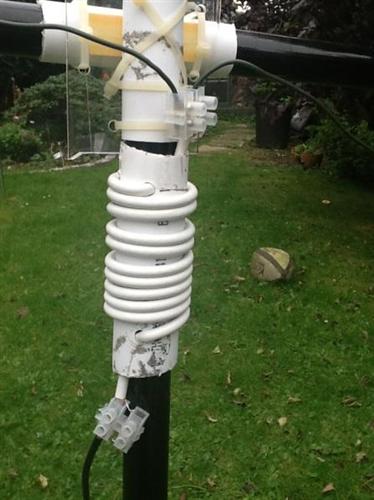
I decided that for the purposes of experimentation (and because I couldn’t be bothered making anything better) I’d use “choc' blocks” for the wire connections and to connect a short length of coax with a PL259 on the end.
So, what to mount the wire and balun on? I picked up 4 Roach poles many years ago quite cheaply and as I don’t fish it made sense to use two of these in a cross configuration. Very easy, or so you’d think. Roach poles have no compression strength (sorry to Martin for standing on his 15M one last Sunday) so mounting them directly was a potential problem; plus I wanted to keep it as light as possible so the use of metal fixings had to be kept to a minimum. I had some smaller white pipe that had been used to send some clansman rods through the post (about 30mm) and that would fit nicely along the fishing rods. There are probably better methods using wooden dowels etc but for this experiment this worked. I cut two pieces about 6” long and checked where they would fit tightly along the fishing rod without crushing.
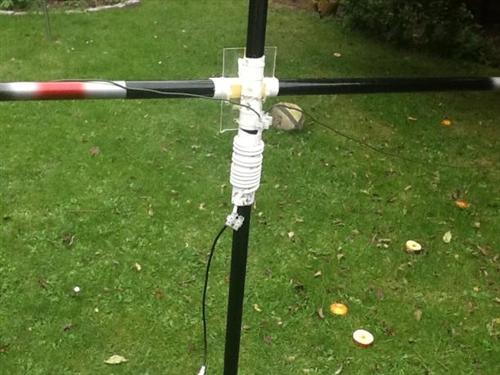
Mounting the crossed rods needed a plate and I had some Perspex from an old leaflet stand (don’t ask) that could be cut up and used. The pictures show the results, mummified to death using cable ties and strong double sided tape – not pretty but it worked! There is some flex in the joints using this method and if a permanent set up is required or high winds are expected then a stronger fixing is definitely needed. The key word was ‘lightness’ so that precluded the use of metal or wood at this stage.
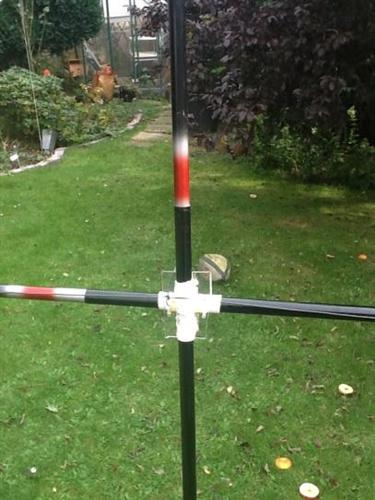
Having a frame to work on really helped and using some scrap ex-military green wire (strong Kevlar filled) it was an easy matter to create the right sized cross and attach the wire.
Fitting the balun caused a few head scratching moments but I did find that with the ends of the balun coil inside the pipe (45mm) it would, with some gentle persuasion, slide over the lower section of the cross and fit close to the ends of the loop wires. Nothing complex but just some lateral thinking, load of tea and a fine day to be working outside – though I did build most of it in the conservatory.
To test it I needed to mount the whole thing up and a common garden umbrella stand did the job perfectly albeit loosely. Most of us have these things and even when the umbrella is dead and gone they tend to hang about with no specific purpose. Now there is one, they are heavy and usually well protected against corrosion and the large socket lets a wide range of temporary masts be inserted. The feed point of the aerial was about 3’ above the ground and the aerial was even free to rotate so all that was left was to test it. I didn’t expect any real problems having made a couple of loops before but neither was I expecting it to be as good as it turned out!
After connecting up a length of coax to my trusty TS940SAT and with the auto tuner off I turned the power down to about 5W of carrier (AM) on 28.500. SWR was 1:1 as expected and increasing the power to 100W no problems were noticed. As usual with loops it feels like the aerial isn’t working as the noise level is un-measurable on a normal ‘S’ meter but almost instantly I was hearing strong eastern Europeans coming through at high signal levels and comparing them with my vertical they were definitely stronger even with the difference in noise.
I was interested to see where the edges were and using a good old fashioned method found that the lower limit (nominally > 2:1) was 26 MHz and the upper limit 29.999 MHz. This is a mono-band aerial but there may be other frequencies where the SWR is 2:1 or lower but this will have to wait for more free time to test.
After building and testing the aerial I moved it to a different spot in the garden and secured it pointing due south. On air tests were unbelievable even with it at a low height. Good DX was achieved with South America (mainly Brazil) and USA stations being worked without too much trouble. The best contact was on 29.014 MHz with a WA4 using 25W AM! Solid and stable copy both ways which took me by surprise. Beaming N-S gave some middle eastern contacts as well, suggesting that there is a side lobe or the beam width is broad.
The final act was to waterproof as much as possible and given the Heath-Robinson construction, cable ties and sharp edges it was decided just to mummify it in Gaffer Tape. It's survived a few serious downpours and a couple of gales at the low height.
The proof was in the pudding, or in this case, the contest. Did it work? Absolutely - if you count St Helena, Guadeloupe, India, South Africa and a host of others as a success.
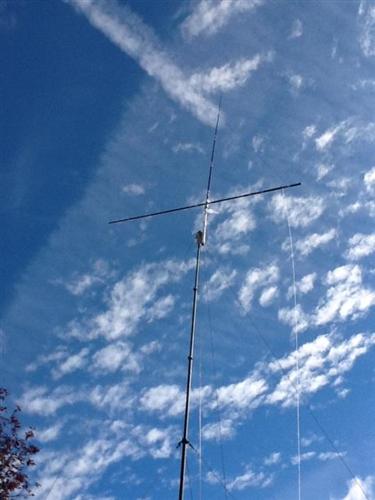
This isn’t a magic aerial or particularly well-constructed for long term use but it proved the design and the effectiveness especially at height. The challenge is to improve it for the long term and for the group to experiment with. It works at very low height and is almost invisible if lost in the trees for those with restrictions or visibility issues. Interestingly, although I have had very good reports from eastern Europe (59+20db in Ukraine) there are no contacts with stations in the far east despite hearing a BY1/0 (Tibet) and the odd Indonesian / Thai one. Despite the good take off from my QTH the angle must be wrong for the East or the signal is getting attenuated by Chanctonbury Ring! – more testing needed.
Did it achieve my objectives?
-
Single band with flat SWR across 28.000 to 29.000 MHz – Yes, easily
-
Lightweight and as compact as possible – Yes, weight is about 2 - 3lb and is reasonably small
-
Portable and reusable – definitely, might need to find a quick erect and release method for /P use though.
-
Made from as much recycled material as possible (from the shack) – yes, nothing had to be bought, the main expense would be the Roach Poles everything else was ‘scrap’
-
Can handle a potential 600W from the Collins 30L-1 Linear. – yes, it seemed to cope well with everything we threw at it and the 600W tests didn’t result in any flames!